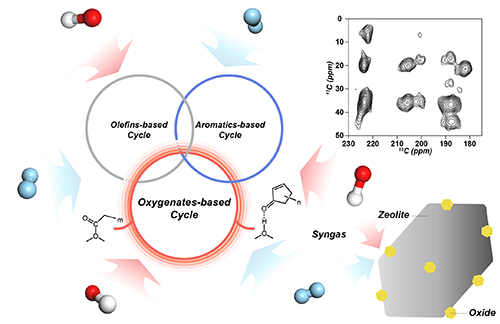A research team led by Prof. HOU Guangjin and Prof. BAO Xinhe from the State Key Laboratory of Catalysis(SKLC) has revealed the oxygenate-based routes in syngas conversion over oxide–zeolite (OXZEO) bifunctional catalysts by solid-state Nuclear Magnetic Resonance (NMR).
This study was published in Nature Catalysis on June 23.
OXZEO catalysis was proposed in 2016 by Prof. BAO Xinhe and Prof. PAN Xiulian from DICP. It provides a platform for the efficient utilization of coal and other carbon resources. However, the reaction mechanism in OXZEO catalysis still remains unclear.

Oxygenate-based routes regulate syngas conversion over OXZEO bifunctional catalysts (Image by JI Yi and GAO Pan)
In this study, the researchers chose the syngas conversion over the ZnAlOx/H-ZSM-5 bifunctional catalyst as a model system to highlight the mechanistic difference in the OXZEO-based syngas direct conversion. ZnAlOx is a typical metal oxide for syngas to methanol process while H-ZSM-5 is a typical zeolite for methanol to hydrocarbons (MTH) reaction.
They used the quasi-in situ solid-state NMR (ssNMR)-Gas Chromatography (GC) analysis strategy to reveal the dynamic evolution of abundant critical and/or transient intermediates, including multi-carbon carboxylates, alkoxyls, acid-bounded methyl-cyclopentenones, and methyl-cyclopentenyl carbocations, from the very early induction period to the steady-state conversion under high-pressure flow-reaction conditions.
Oxygenate-based routes were proved to be contributed to the outlet olefins and aromatics, where the feed, i.e., CO and H2, was also a vigorous participant in these secondary reactions. In addition to the ZnAlOx/H-ZSM-5 catalyst, the researchers also discovered that the key intermediates exist in multiple OXZEO catalysts, proving the universality of oxygenate-based routes in OXZEO-based syngas conversion.
"Our findings provide new insights into the reaction mechanism of syngas conversion on bifunctional catalysts, and may also help to better understand the mechanism of CO2 and biomass conversion," said Prof. HOU.
This work was supported by the National Key R&D Programs of China, the National Natural Science Foundation of China, the Liaoning Revitalization Talents Programs, the China National Postdoctoral Programs for Innovative Talents, and the China Postdoctoral Science Foundation. (Text by JI Yi and GAO Pan)